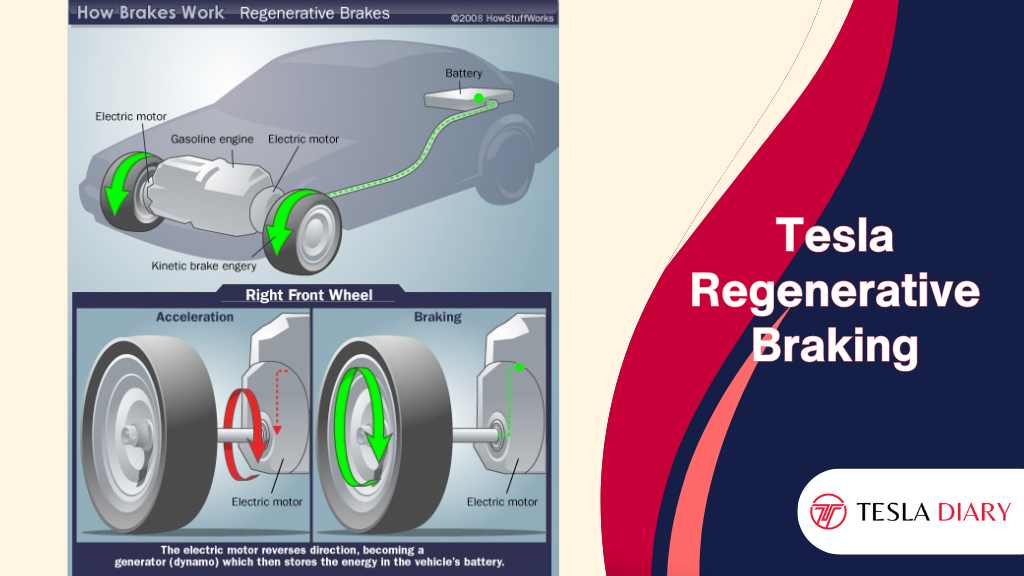Tesla’s innovative regenerative braking technology has become a hallmark feature of their electric vehicles (EVs), revolutionizing the driving experience and contributing to energy efficiency.
This article explores the concept of regenerative braking, how it works in Tesla vehicles, its benefits, and its impact on the future of automotive technology.

What is Regenerative Braking?
Regenerative braking, often referred to as regen braking, is a braking system employed in electric and hybrid vehicles to recover and store energy that would otherwise be wasted as heat during braking.
Traditional internal combustion engine (ICE) vehicles rely on friction-based brakes to slow down and stop, dissipating kinetic energy as heat.
In contrast, regenerative braking systems in EVs and hybrids aim to convert this kinetic energy back into usable electrical energy.
How Does Regenerative Braking Work?
Regenerative braking operates on the principle of electromagnetic induction. When the driver applies the brakes, the electric motor in the vehicle temporarily reverses its role, acting as a generator. Here’s a simplified step-by-step explanation of how it works:
Kinetic Energy Conversion: When you lift your foot off the accelerator or apply the brake pedal, the electric motor switches into generator mode. The wheels’ kinetic energy, which would typically be lost as heat in traditional braking systems, is now converted into electrical energy.
AC to DC Conversion: The electrical energy generated is in the form of alternating current (AC). It is then converted into direct current (DC) to be compatible with the vehicle’s battery system.
Energy Storage: The DC electrical energy is directed to the vehicle’s high-voltage battery pack, where it is stored for future use.
Energy Reutilization: This stored energy can be later used to power the vehicle, reducing the overall energy consumption and increasing the driving range.
Tesla’s Regenerative Braking System
Tesla’s Unique Approach
Tesla’s electric vehicles are known for their advanced regenerative braking systems, which provide a seamless and efficient driving experience. Key features of Tesla’s regen braking include:
Variable Regeneration Levels: Tesla vehicles allow drivers to adjust the level of regenerative braking using the regen settings. This flexibility allows drivers to choose a regen level that suits their driving style.
Single-Pedal Driving: With strong regen capabilities, Tesla vehicles enable “one-pedal driving.” This means that in many situations, drivers can accelerate and decelerate using only the accelerator pedal, making driving more intuitive and efficient.
Automatic Regen: Tesla’s regen system is also equipped with a predictive element that uses sensors and cameras to anticipate the need for braking, optimizing regen levels accordingly. For instance, when the vehicle detects traffic slowing down ahead, it can increase regen to slow the car.
Energy Visualization: Tesla’s infotainment system provides drivers with real-time data on energy regeneration and consumption, allowing them to understand and maximize the benefits of regen braking.
Maximizing Energy Efficiency
Tesla has continually refined its regenerative braking technology to maximize energy efficiency. This not only improves the driving range but also reduces wear and tear on the traditional friction brakes, extending their lifespan.
Brake Blending
Tesla’s regen braking system also intelligently blends regen and traditional friction braking to provide a smooth and responsive braking experience.
When you apply the brake pedal more forcefully or need to come to a complete stop quickly, the vehicle will seamlessly transition to friction braking to ensure safety and control.
Benefits of Tesla’s Regenerative Braking
Extended Range
One of the most significant advantages of regenerative braking in Tesla vehicles is the extension of driving range.
By recapturing and storing energy during braking, Tesla cars can travel farther on a single charge compared to their non-regen counterparts.
Reduced Brake Wear
Since regenerative braking relies on the electric motor for most of the deceleration, traditional brake pads and rotors experience significantly less wear and tear.
This results in longer brake component lifespan and reduced maintenance costs for Tesla owners.
Enhanced Driving Experience
Tesla’s regen braking contributes to a unique and enjoyable driving experience.
One-pedal driving, where acceleration and deceleration are controlled primarily by the accelerator pedal, simplifies city driving and stop-and-go traffic situations.
Environmental Impact
Regenerative braking aligns with Tesla’s commitment to sustainability. By reusing energy that would otherwise be lost, Tesla vehicles have a smaller carbon footprint compared to ICE vehicles, even when factoring in the environmental impact of battery production.
Future Implications
Widespread Adoption
As electric vehicles gain traction in the automotive industry, regenerative braking is becoming a standard feature in many EV models.
Tesla’s success in implementing and promoting this technology has influenced other manufacturers to adopt similar systems in their vehicles.
Enhanced Efficiency
Ongoing research and development efforts are focused on improving the efficiency of regenerative braking systems.
Future advancements may lead to even more energy recovery, reducing the need for traditional friction braking further.
Grid Integration
Regenerative braking technology opens up the possibility of vehicle-to-grid (V2G) integration. In the future, Tesla and other automakers may allow owners to discharge the stored regen energy back to the grid during peak demand, contributing to a more stable and sustainable energy ecosystem.
Conclusion
Tesla’s regenerative braking system represents a significant leap forward in automotive technology.
By harnessing the power of electromagnetic induction, Tesla vehicles maximize energy efficiency, extend driving range, and enhance the overall driving experience.
As the automotive industry continues to evolve towards electrification, regenerative braking is poised to become a standard feature, contributing to a greener and more sustainable future for transportation.
Tesla’s innovation in this field not only benefits their vehicles and drivers but also has broader implications for the entire automotive ecosystem.

